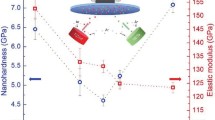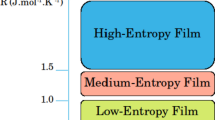Abstract
To develop high-quality refractory metal targets, pure W and W/Re alloys (with Re contents of 1, 5 and 10 mass%) were fabricated via mechanical mixing, press forming and vacuum sintering. Properties such as relative density, grain size and orientation, and magnetron sputtering characteristics were investigated in the W/Re alloys. With increasing Re content, both the relative density and purity of the W-Re alloys increased, while the grain size decreased. The sizes of the grains in the W/10 mass% Re alloy target were mainly between 10 and 40 μm. The results of electron backscatter diffraction (EBSD) indicated that the grains in the W/Re alloys were randomly distributed and did not have a preferred orientation. The percentage of small-angle grain boundaries (< 10°) was greater than 85% in the W/10 mass% Re alloy. The grains in W/Re alloy thin films became gradually refined with increasing deposition pressure during magnetron sputtering. Additionally, the surface roughness of the thin films gradually decreased and the thickness of the thin films gradually increased with increasing deposition pressure. X-ray diffraction (XRD) patterns of the thin films exhibited (110), (200) and (211) diffraction peaks at 40.5°, 58.6° and 73.5°, respectively. With increasing deposition pressure, the intensity of the (110) diffraction peak gradually decreased, while the intensity of the (200) diffraction peak gradually increased.














Similar content being viewed by others
References
Y. Yu, J.P. Song, F. Bai, A.L. Zheng and F.S. Peng, Ultra-high Purity Tungsten and Its Applications, Int. J Refract. Met. Hard Mater., 2015, 53, p 98–103.
X.Y. Wei, Preparation Technology and Application of High Purity Tungsten Target for Semiconductor, Cemented Carbide, 2017, 34, p 353–359.
F. Bai, The Study of Preparing of High Purity Tungsten Alloy Targets, A Dissertation Submitted to Xiamen University for Master Degree of Materials Engineering, Xiamen: Xiamen University, 2015, p 40-43
Y.Z. Ma, Y. Liu, W.S. Liu and L.P. Long, Preparation Procedure of High Purity Tungsten Via Electron Beam Side Surface Melting, Mater. Sci. Technol., 2014, 22, p 30–35.
Z.H. Wang, M.X. Wang, M.Y. Chu, F. Guo, X. Zhao and J.Y. Shen, Preparation of W-Ti Sputtering Targets under Inert Atmosphere, Chin. J. Rare Met., 2006, 30, p 687–691.
Z.C. Ding, M. Chen, S.Q. Liu, X.P. Wang and B.G. Lv, Preparation of High Purity W-Si Alloy Powder, Rare Metal Mat. Eng., 2014, 43, p 1269–1271.
Z.C. Ding, J.J. He, J.F. Luo, Y.J. Li and X.D. Xiong, Effects of Vacuum Hot Pressing Sintering on the Performance of High Purity W-Si Alloy Target, Rare Metal Mat. Eng., 2014, 43, p 1403–1406.
Q.X. Wang and Z.K. Fan, Application and Manufacturing Technology of Tungsten and Tungsten-titanium Targets, Powder Metall. Technol., 2009, 27, p 52–57.
Y.M. Wang, Q.H. Tang, D.Q. Chen, X.B. Liu, J.H. Yan and X. Xiong, Microstructure and Magnetron Sputtering Properties of Tungsten Target Fabricated by Low Pressure Plasma Spraying, Int. J. Refract. Met. Hard Mater., 2020, 87(105116), p 1–10.
Y.M. Wang, Q.H. Tang, Z.Q. Yan and F. Wang, Influence of Vacuum Chamber Pressure on Microstructure and Properties of Tungsten Target Fabricated by Low Pressure Plasma Spraying, J. Mater. Eng., 2018, 46, p 104–112.
B. Gao, L.F. Shao and H.F. Zhang, Preparation and Properties of Metal Tungsten Sputtering Target, World Nonferr. Met., 2017, 33, p 249–250.
A.R. Lipski and R.S. Lefferts, Making Tungsten Targets Using Tungsten Oxide Powder, Nucl. Instrum. Methods Phys. Res. Sect. A, 2011, 655, p 41–43.
Y.Z. Jin, D.L. Liu and J. Chen, Studying on Manufacture and Application of Sputtering Target Materials, J. Sichuan Univ. Sci. Eng. Nat. Sci. Ed., 2005, 18, p 22–24.
A.H. Yang, Y. Zhu, Z.M. Deng, H.C. Xie, G.Q. Zhang and F. Wu, Investigation on Microstructure and Texture in High Pure Gold Sputtering Targets by EBSD, Precious Metal., 2014, 35, p 44–48.
Y.Q. Xia, D.C. Wang, J.S. Wang, E.K. Zhu and S.L. Yin, Study on High Temperature Molybdenum Alloy Doped with Rare-earth Element, Chin. Molybden. Indus., 2001, 25, p 76–78.
S.E. Hornstrom, T. Lin, O. Thomas, P.M. Fryer and J.M.E. Harper, Tungsten-rhenium Alloys as Diffusion Barriers between Aluminum and Silicon, J. Vacuum Sci. Technol., 1988, 6, p 1650–1655.
H. Lange, W. Möhling and G. Marxsen, W-Re (6 wt.%) and W-Ti (10 wt.%) Alloys as Diffusion Barriers between Aluminum and Silicon, Thin Solid Films, 1991, 205, p 47-51
S.O. Safonov, V.P. Bespalov, A.A. Golishnikov and M.G. Putrya, Estimating the Reliability of Aluminum Metallization of Integrated Circuits by Accelerated Electromigration Testing at Constant Temperature, Russ. Microelectron., 2015, 44, p 453–459.
I. De Munari, A. Scorzoni, F. Tamarri and D. Govoni, Drawbacks to Using NIST Electromigration Test-structures to Test Bamboo Metal Lines, IEEE Trans. Electron Dev., 1994, 41, p 2276–2280.
T.Y. Cheng, N. Xiong, K.Y. Peng, H.B. Yang and J.C. Yin, The Aplication and Preparation Technology of Rhenium and Rhenium Alloys, Rare Metal Mat. Eng., 2009, 38, p 373–376.
H.Z. Wang and S.L. Yang, Character, Application and Preparation Method of Rhenium, J Chin. Rare Earth Soc., 2005, 23, p 189–193.
Z.Q. Cui and B.X. Liu, Metallurgy and Heat Treatment Principle, Haerbin Institute of Technology Press, Haerbin, 1998.
J.J. Park, Creep Strength of a Tungsten–rhenium–hafnium Carbide Alloy from 2200 to 2400 , Mater. Sci. Eng. A, 1999, 265, p 174–178.
K. Yang, B. Cao and W.J. Yu, Precise Resistance Spot Welding of Automotive Lamp, Electr. Weld. Mach., 2010, 40, p 139–141.
A. H. Luo, and D. L. Jacobson, Creep Behavior of a Tungsten-3.6%rhenium-0.33%zirconium Carbide Alloy, Int. J. Refract. Met. Hard Mater., 1992, 11, p 97-103
L.Y. Wang, C.Z. Wang, J. Ma and Y.Y. Hou, The Technics of W-Re Alloy Coating by Chemical Vapor Deposition, China Surf. Eng., 2006, 19, p 39–42.
Y.M. Wang, M.H. Chen, Y. Li, K.W. Tang, W.W. Ding, X. Xiong, Q.L. Shi, L. Xie and X. Xu, Near-net-shape Tungsten-rhenium Alloy Parts Produced by Shrouded Plasma Spray Forming, J. Aeronaut. Mater., 2016, 36, p 24–34.
Y.M. Wang, X. Xiong, Z.W. Zhao, X. Lu, J.H. Yan, X.B. Min and F. Zheng, Near-net-shape Tungsten-rhenium Alloy Parts Produced by Plasma Spray Forming and Hot Isostatic Pressing, Mater. Trans., 2014, 55, p 713–721.
S. Pramanik, A. K. Srivastav, B. Manuel Jolly, N. Chawake, and B. S. Murty, Effect of Re on Microstructural Evolution and Densification Kinetics During Spark Plasma Sintering of Nanocrystalline W, Adv. Powder Technol., 2019, 30, p 2779-2786
C.F. Lo, P. Mcdonald, D. Draper and P. Gilman, Influence of Tungsten Sputtering Target Density on Physical Vapor Deposition Thin Film Properties, J. Electron. Mater., 2005, 34, p 1468–1473.
T. Leonhardt, C. Trybus and R. Hickman, Consolidation Methods for Spherical Rhenium and Rhenium Alloys, Powder Metall., 2003, 46, p 148–153.
R.I. Jaffee, C.T. Sims, and J. J. Hardwood, The Effect of Rhenium on the Fabrication and Ductility of Molybdenum and Tungsten, In Proceedings of 3rd Plansee-Seminar Proceedings (Reutte, Austria: Plansee Group), 1958, p 380-410
K. Johann, L. Alexander, K. Daniel, C. Helmut, and M.K. Verena, Thermally Activated Deformation Mechanisms and Solid Solution Softening in W-Re Alloys Investigated via High Temperature Nanoindentation, Mater. Design, 2020, 189, p (108499)1-6
H. Wang, M.X. Xia, Y.C. Li, X.F. Liu, X.M. Cai, R. Bai and X. Zhang, Treatment of Ammonia Nitrogen Waste Water from Tungsten Smelter by Breakpoint Chlorination, Chin. Tungsten Indus., 2019, 34, p 64–69.
Z.J. Liu, Y.X. Chen, W.J. Huang and H.J. Huang, Manufacture and Application of Sputtering Target Materials, South. Metal., 2003, 23, p 23–25.
Q. Tan, Manufacture and Application of Mo-Re Alloys, Chin. Molybden. Indus., 1998, 22, p 26–28.
X.S. Yin, Tungsten/Rhenium Alloy and Tungsten/Rhenium Thermocouple, Metall. Indus. Press, Beijing, 1992, p 7
C. Guan, J.J. He, H. Zeng, X.Y. Wang and Y.J. Li, Microstructure and Texture Evolution of Ultra-high Pure CuMn Alloy Material, Chin. Rare Metal., 2017, 41, p 120–125.
C.B. Wei, M.J. Dai, H.J. Hou, S.S. Lin and L. Zhao, Influence of Deposition Pressure on Structure and Tribological Properties of W-S-C Composite Films, Lubr. Eng., 2012, 37, p 69–73.
J.T. He, H.C. Cai and Y.J. Xue, Effect of Deposition Pressure on Tribological Properties of WS2 Films by Magnetron Sputtering, Surf. Technol., 2020, 49, p 180–187.
Acknowledgments
This work was supported by National Natural Science Foundation of China (Grant No. 51701072 and Grant No. 52011530147), Natural Science Foundation of Hunan Province of China (Grant No. 2016JJ5029, 2017JJ3088 and 2020JJ4738), Military and Civilian Integration Industry Development Special Foundation of Hunan Province (Grant No. 2016B116J1), National United Engineering Laboratory for Advanced Bearing Tribology (Henan University of Science and Technology, Grant No. 201913) and Hunan Province Key Laboratory of Materials Surface & Interface Science and Technology (Central South University of Forestry and Technology, Grant No. KFBJM2019002).
Author information
Authors and Affiliations
Corresponding author
Additional information
Publisher's Note
Springer Nature remains neutral with regard to jurisdictional claims in published maps and institutional affiliations.
Rights and permissions
About this article
Cite this article
Wang, Y.M., Tang, Q.H. & Zhou, P. Microstructure and Magnetron Sputtering Properties of W/Re Alloy Targets Fabricated by Vacuum Sintering. J. of Materi Eng and Perform 30, 7223–7235 (2021). https://doi.org/10.1007/s11665-021-05907-w
Received:
Revised:
Accepted:
Published:
Issue Date:
DOI: https://doi.org/10.1007/s11665-021-05907-w




